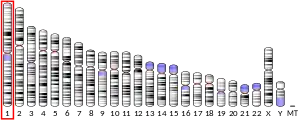HES5
Transcription factor HES-5 is a protein that in humans is encoded by the HES5 gene.[5][6]
HES5 regulates brain development process.[7] HES5 expression significantly higher in squamous cervical carcinoma than in CIN as well as higher in CIN than normal cervical epithelia.[8] Human HES5 gene binds to Notch receptor and expression of HES5 decreases during cartilage differentiation.[9]
References
- ENSG00000197921 GRCh38: Ensembl release 89: ENSG00000273529, ENSG00000197921 - Ensembl, May 2017
- GRCm38: Ensembl release 89: ENSMUSG00000048001 - Ensembl, May 2017
- "Human PubMed Reference:". National Center for Biotechnology Information, U.S. National Library of Medicine.
- "Mouse PubMed Reference:". National Center for Biotechnology Information, U.S. National Library of Medicine.
- Takebayashi K, Akazawa C, Nakanishi S, Kageyama R (Feb 1995). "Structure and promoter analysis of the gene encoding the mouse helix-loop-helix factor HES-5. Identification of the neural precursor cell-specific promoter element". J Biol Chem. 270 (3): 1342–9. doi:10.1074/jbc.270.3.1342. PMID 7836401.
- "Entrez Gene: HES5 hairy and enhancer of split 5 (Drosophila)".
- Hatakeyama J, Bessho Y, Katoh K, Ookawara S, Fujioka M, Guillemot F, Kageyama R (November 2004). "Hes genes regulate size, shape and histogenesis of the nervous system by control of the timing of neural stem cell differentiation". Development. 131 (22): 5539–50. doi:10.1242/dev.01436. PMID 15496443.
- Liu J, Ye F, Chen H, Lü W, Zhou C, Xie X (2007). "Expression of differentiation associated protein Hes1 and Hes5 in cervical squamous carcinoma and its precursors". Int. J. Gynecol. Cancer. 17 (6): 1293–9. doi:10.1111/j.1525-1438.2007.00930.x. PMID 17388915. S2CID 25609083.
- Karlsson C, Jonsson M, Asp J, Brantsing C, Kageyama R, Lindahl A (March 2007). "Notch and HES5 are regulated during human cartilage differentiation". Cell Tissue Res. 327 (3): 539–51. doi:10.1007/s00441-006-0307-0. PMID 17093926. S2CID 33749726.
Further reading
- Strausberg RL, Feingold EA, Grouse LH, et al. (2003). "Generation and initial analysis of more than 15,000 full-length human and mouse cDNA sequences". Proc. Natl. Acad. Sci. U.S.A. 99 (26): 16899–903. doi:10.1073/pnas.242603899. PMC 139241. PMID 12477932.
- Gazit R, Krizhanovsky V, Ben-Arie N (2004). "Math1 controls cerebellar granule cell differentiation by regulating multiple components of the Notch signaling pathway". Development. 131 (4): 903–13. doi:10.1242/dev.00982. PMID 14757642.
- Nakatani T, Mizuhara E, Minaki Y, et al. (2004). "Helt, a novel basic-helix-loop-helix transcriptional repressor expressed in the developing central nervous system". J. Biol. Chem. 279 (16): 16356–67. doi:10.1074/jbc.M311740200. PMID 14764602.
- Kamakura S, Oishi K, Yoshimatsu T, et al. (2004). "Hes binding to STAT3 mediates crosstalk between Notch and JAK-STAT signalling". Nat. Cell Biol. 6 (6): 547–54. doi:10.1038/ncb1138. PMID 15156153. S2CID 36887899.
- Katoh M, Katoh M (2005). "Identification and characterization of human HES2, HES3, and HES5 genes in silico". Int. J. Oncol. 25 (2): 529–34. doi:10.3892/ijo.25.2.529. PMID 15254753.
- Ohtsuka T, Imayoshi I, Shimojo H, et al. (2006). "Visualization of embryonic neural stem cells using Hes promoters in transgenic mice". Mol. Cell. Neurosci. 31 (1): 109–22. doi:10.1016/j.mcn.2005.09.006. PMID 16214363. S2CID 35470002.
- Ong CT, Cheng HT, Chang LW, et al. (2006). "Target selectivity of vertebrate notch proteins. Collaboration between discrete domains and CSL-binding site architecture determines activation probability". J. Biol. Chem. 281 (8): 5106–19. doi:10.1074/jbc.M506108200. PMID 16365048.
- Gregory SG, Barlow KF, McLay KE, et al. (2006). "The DNA sequence and biological annotation of human chromosome 1". Nature. 441 (7091): 315–21. Bibcode:2006Natur.441..315G. doi:10.1038/nature04727. PMID 16710414.
- Karlsson C, Brantsing C, Svensson T, et al. (2007). "Differentiation of human mesenchymal stem cells and articular chondrocytes: analysis of chondrogenic potential and expression pattern of differentiation-related transcription factors". J. Orthop. Res. 25 (2): 152–63. doi:10.1002/jor.20287. PMID 17072841.
- Karlsson C, Jonsson M, Asp J, et al. (2007). "Notch and HES5 are regulated during human cartilage differentiation". Cell Tissue Res. 327 (3): 539–51. doi:10.1007/s00441-006-0307-0. PMID 17093926. S2CID 33749726.
External links
- HES5+protein,+human at the US National Library of Medicine Medical Subject Headings (MeSH)
This article incorporates text from the United States National Library of Medicine, which is in the public domain.
This article is issued from Wikipedia. The text is licensed under Creative Commons - Attribution - Sharealike. Additional terms may apply for the media files.



